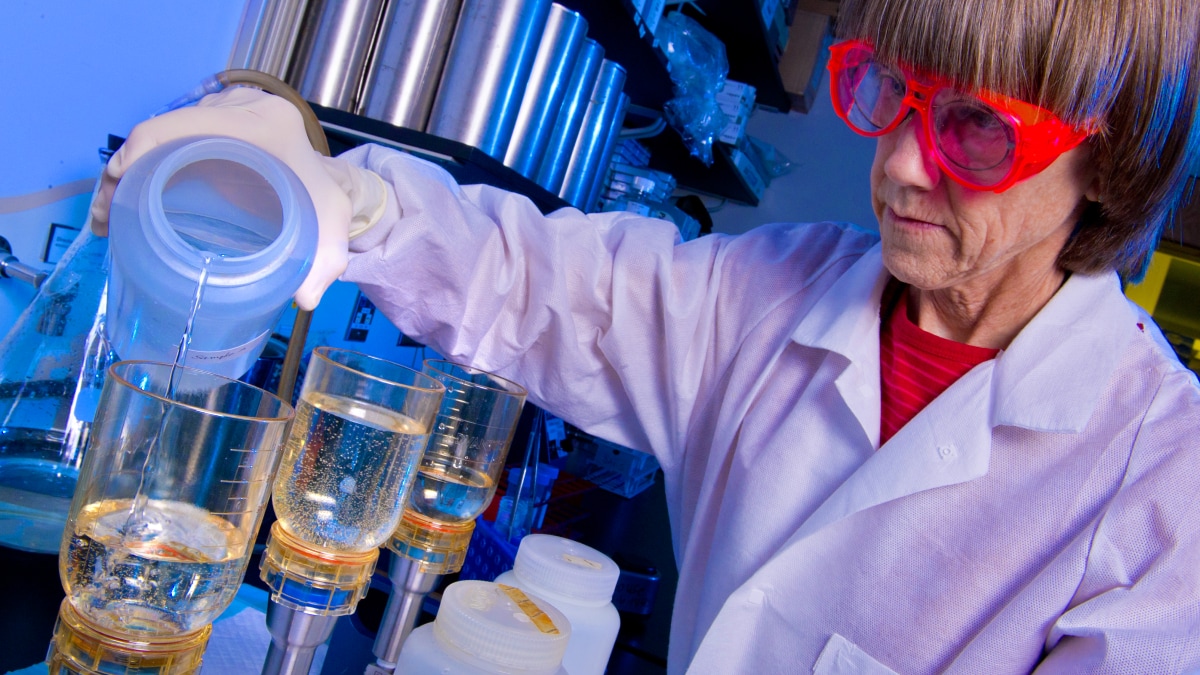Key points
- Clinical laboratories can provide diagnostic testing for Legionella infections using culture, serology, or molecular methods.
- CDC recommends culture and Legionella urinary antigen testing (UAT) together for diagnosis of Legionnaires' disease.

Preferred methods
The preferred diagnostic tests for Legionnaires' disease are both of the following paired together:
- Culture of lower respiratory secretions
- Legionella UAT
Lower respiratory secretions include sputum and bronchoalveolar lavage.
Importance of culture
Culturing specimens is important to enable detection of all species and serogroups of Legionella. Culturing can detect Legionella species and serogroups that the UAT doesn't as it only detects L. pneumophila serogroup 1.
Culture also allows for comparison of clinical and environmental isolates during an outbreak investigation.
Benefits of the urinary antigen test
The UAT is the most commonly used laboratory test for diagnosis of Legionnaires’ disease. It detects a molecule of the Legionella bacterium in urine. It can detect Legionella in some cases for days to weeks (or longer, under rare circumstances) after treatment.
Lab methods
Sensitivity and specificity
Sensitivity varies depending on the following:
- Quality and timing of clinical specimen collection
- Technical skill of the laboratory worker performing the test
| Test | Sensitivity (%) | Specificity (%) |
|---|---|---|
| Culture | 20–80 | 100 |
| Urinary antigen for L. pneumophila serogroup 1A (Lp1) | 70–100 | 95–100 |
| Polymerase Chain Reaction (PCR)B | 95–99 | >99 |
| Direct Fluorescent Antibody (DFA) Stain | 25–75 | >95 |
| Paired serologyC | 80–90 | >99 |
Advantages and disadvantages
| Test | Advantages | Disadvantages |
|---|---|---|
| Culture |
|
|
| Urinary Antigen |
|
|
| Nucleic Acid Amplification Test |
|
|
| DFA |
|
|
| Serology |
|
|
Specimen collection
Best practice is to obtain both lower respiratory culture and urine concurrently.
It's ideal to obtain the lower respiratory culture prior to antibiotic administration. However, antibiotic treatment shouldn't be delayed to facilitate this process. Culture can be attempted even after antibiotic therapy has been initiated.
Submitting specimens
Public health department laboratory staff can forward approved specimens to CDC for specialized testing.
Bacteria detection
Incorrect rejection criteria
Laboratories sometimes reject lower respiratory specimens during a work-up for pneumonia based on specimen quality. Issues can include a lack of white blood cells in the sample or contamination with other bacteria.
However, laboratories shouldn't reject lower respiratory specimens for these reasons when working-up Legionnaires' disease because Legionella can often be recovered. Sputum produced by patients with Legionnaires' disease may not have many white blood cells1. Contaminating bacteria don't negatively impact isolation of Legionella on selective media (e.g., Buffered Charcoal Yeast Extract [BCYE] agar plus antibiotics)2.
Resources
Environmental Legionella Isolation Techniques Evaluation Program
Laboratories are able to test their proficiency at isolating Legionella from simulated environmental samples. This program issues documentation to those who pass the proficiency test.
Legionella Reference Center quick reference guide
This reference center accepts testing requests from governmental public health or environmental laboratories. It performs Legionella testing on clinical specimens and isolates, as well as environmental isolates and outbreak samples.
- Cross reactions with other species and serogroups have been documented.
- Avni T, Bieber A, Green H, et al. Diagnostic accuracy of PCR alone and compared to urinary antigen testing for detection of Legionella spp.: A systematic review. J Clin Micro. 2016;54(2):401–11.
- CDC labs don't perform serologic testing for legionellosis diagnosis due to inherent challenges in obtaining appropriate specimens. It's important to note that because paired sera are required, results are delayed and thus may not be useful for acute case diagnosis or during active outbreak investigations.
- Yu V, Plouffe JF, Pastoris MC, et al. Distribution of Legionella species and serogroups isolated by culture in patients with sporadic community-acquired legionellosis: An international collaborative survey. J Infect Dis. 2002;186:127–8.
- Laboratories can develop, adopt, or use existing assays (known as laboratory developed tests) for in vitro diagnostic purposes. Labs do this by establishing and validating test performance under the Clinical Laboratory Improvement Amendments of 1988 (CLIA) requirements or equivalent regulations.
- Currently the U.S. Food and Drug Administration has cleared at least one nucleic acid-based molecular assay for Legionella pneumophila detection.
- McDade JE, Shepard CC, Fraser DW, Tsai TR, Redus MA, Dowdle WR. Legionnaires' disease: Isolation of a bacterium and demonstration of its role in other respiratory disease. N Engl J Med. 1977;297(22):1197–203.
- Murdoch DR. Diagnosis of Legionella infection. Clin Infect Dis. 2003;36:64–9.
- Mercante JW, Winchell JM. Current and emerging Legionella diagnostics for laboratory and outbreak investigations. Clin Microbiol Rev. 2015;28:80–118.
